Articles
- Page Path
- HOME > J Musculoskelet Trauma > Volume 21(2); 2008 > Article
-
Original Article
- Treatment of Intertrochanteric Fracture: Comparison of Proximal Femoral Nail and Proximal Femoral Nail A
- Jung Ho Park, M.D., Jong Woong Park, M.D., Joon Ho Wang, M.D., Jae Wook Lee, M.D., Jung Il Lee, M.D., Jae Gyoon Kim, M.D.
-
Journal of the Korean Fracture Society 2008;21(2):103-109.
DOI: https://doi.org/10.12671/jkfs.2008.21.2.103
Published online: April 30, 2008
Department of Orthopaedic Surgery, Ansan Hospital, College of Medicine, Korea University, Ansan, Korea.
- Address reprint requests to: Jung Ho Park, M.D. Department of Orthopaedic Surgery, Korea University Ansan Hospital, 516, Gojan 1-dong, Danwon-gu, Ansan 425-707, Korea. Tel: 82-31-412-5960, Fax: 82-31-439-3852, canal1@korea.ac.kr
Copyright © 2008 The Korean Fracture Society. All rights reserved.
This is an Open Access article distributed under the terms of the Creative Commons Attribution Non-Commercial License (http://creativecommons.org/licenses/by-nc/3.0/) which permits unrestricted non-commercial use, distribution, and reproduction in any medium, provided the original work is properly cited.
- 608 Views
- 0 Download
- 6 Crossref
Abstract
-
Purpose
- To evaluate the results of fracture fixation between using Proximal Femoral Nail and using Proximal Femoral Nail A and to analyze the effectiveness of proximal femoral nail A.
-
Materials and Methods
- We reviewed 32 patients who suffered from intertrochanteric fracture in our hospital, which were 19 cases of PFN and 13 cases of PFNA. Retrospectively we evaluated mean operation time, amount of bleeding, beginning of ambulation, average union period, changes of neck shaft angle and complication on set of telephone interview and OPD. We also evaluated postoperative capability of function and mobility using 'Social function score' and 'Mobility score'.
-
Results
- PFNA showed shorter mean operation time, less bleeding, shorter average union period, earlier ambulation and less change of neck shaft angle than PFN. Although they didn't show statistical difference, postoperative capability of function and mobility showed statistical and mathematical difference on each group.
-
Conclusion
- PFNA showed better results of postoperative function and mobility and less complications than PFN. So treatment using PFNA is better method than that of PFN.
- 1. Ahn SJ, Park JH. Proximal femoral nail (PFN) for the treatment of the femoral trochanteric fracture. J Korean Fract Soc, 2004;17:7-12.Article
- 2. Al-yassari G, Langstaff RJ, Jones JW, Al-Lami M. The AO/ASIF proximal femoral nail (PFN) for the treatment of unstable trochanteric femoral fracture. Injury, 2002;33:395-399.Article
- 3. Bess RJ, Jolly SA. Comparison of compression hip screw and gamma nail for treatment of peritrochanteric fractures. J South Orthop Assoc, 1997;6:173-179.
- 4. Boriani S, Bettelli G. The Gamma nail. A preliminary note. Chir Organi Mov, 1990;75:67-70.
- 5. Bridle SH, Patel AD, Bircher M, Calvert PT. Fixation of intertrochanteric fractures of the femur. A randomised prospective comparison of the gamma nail and the dynamic hip screw. J Bone Joint Surg Br, 1991;73:330-334.ArticlePDF
- 6. Domingo LJ, Cecilia D, Herrera A, Resines C. Trochanteric fractures treated with a proximal femoral nail. Int Orthop, 2001;25:298-301.ArticlePDF
- 7. Halder SC. The gamma nail for peritrochanteric fractures. J Bone Joint Surg Br, 1992;74:340-344.
- 8. Herrera A, Domingo LJ, Calvo A, Martinez A, Cuenca J. A comparative study of trochanteric fractures treated with the Gamma nail or the proximal femoral nail. Int Orthop, 2002;26:365-369.ArticlePDF
- 9. Ito K, Hungerbühler R, Wahl D, Grass R. Improved intramedullary nail interlocking in osteoporotic bone. J Orthop Trauma, 2001;15:192-196.Article
- 10. Jensen JS. Determining factors for the mortality following hip fractures. Injury, 1984;15:411-414.Article
- 11. Kim BS, Lew SG, Ko SH, Cho SD, Yang JH, Park MS. Treatment of femoral intertrochanteric fracture with proximal femoral nail. J Korean Fract Soc, 2004;17:1-6.
- 12. Lenich A, Mayr E, Ruter A, Mockl C, Füchtmeier B. First results with the trochanter fixation nail (TFN): a report on 120 cases. Arch Orthop Trauma Surg, 2006;126:706-712.ArticlePDF
- 13. Lindsey RW, Teal P, Probe RA, Rhoads D, Davenport S, Schauder K. Early experience with the gamma interlocking nail for peritrochanteric fractures of the proximal femur. J Trauma, 1991;31:1649-1658.
- 14. Moon YW, Seo HS, Eun SS, Lim SJ, Park YS. Comparison of the Gamma nail and the proximal femoral nail in the treatment of intertrochanteric fracture. J Korean Hip Soc, 2007;19:97-104.
- 15. Moon YW, Suh DH, Kang ST, Kwon DJ, Ji YN, Lee KB. The proximal femoral nail for intertrochanteric fracture of the femur. J Korean Soc Fract, 2003;16:29-36.
- 16. Parker MJ, Palmer CR. A new mobility score for predicting mortality after hip fracture. J Bone Joint Surg Br, 1993;75:797-798.
- 17. Schipper IB, Steyerberg EW, Castelein RM, et al. Treatment of unstable trochanteric fractures. Randomised comparison of the gamma nail and the proximal femoral nail. J Bone Joint Surg Br, 2004;86:86-94.
- 18. Simmermacher RK, Bosch AM, Van der Werken C. The AO/ASIF-proximal femoral nail (PFN): a new device for the treatment of unstable proximal femoral fractures. Injury, 1999;30:327-332.
- 19. Singh M, Nagrath AR, Maini PS. Changes in trabecular pattern of the upper end of the femur as an index of osteoporosis. J Bone Joint Surg Am, 1970;52:457-467.
- 20. Strauss E, Frank J, Lee J, Kummer FJ, Tejwani N. Helical blade versus sliding hip screw for treatment of unstable intertrochanteric hip fractures: a biomechanical evaluation. Injury, 2006;37:984-989.
REFERENCES
Fig. 1
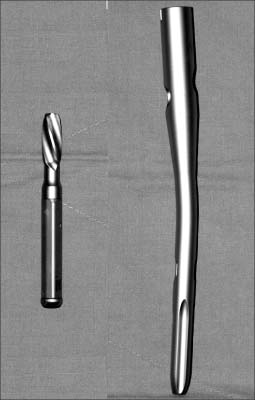
Proximal femoral nail A (PFNA) and its components (helical blade and its assembly device and nail).

Fig. 2
(B) We performed closed reduction and intramedullary fixation using PFN.
(C) Radiograph which was taken 3 weeks later shows distal migaration of hip pin and neck screw.
(D) 14 months later post-operatively, radiograph shows more migration of hip pin and neck screw but union was obtained. She complained of pain because of protruded hip pin and neck screw.
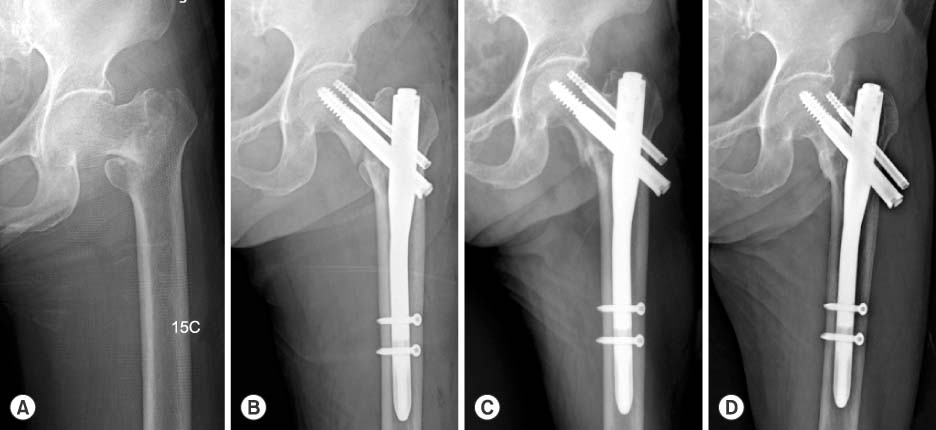
(A) 72 year old female patient presented with intertrochanteric fracture as AO/ASIF classification A1.1.

Fig. 3
(B) Postoperative radiograph shows closed reduction and intramedullary fixation using PFN.
(C) Radiograph taken 9 months later shows more migration of hip pin but union was obtained.
(D) So we performed removal of hip pin.
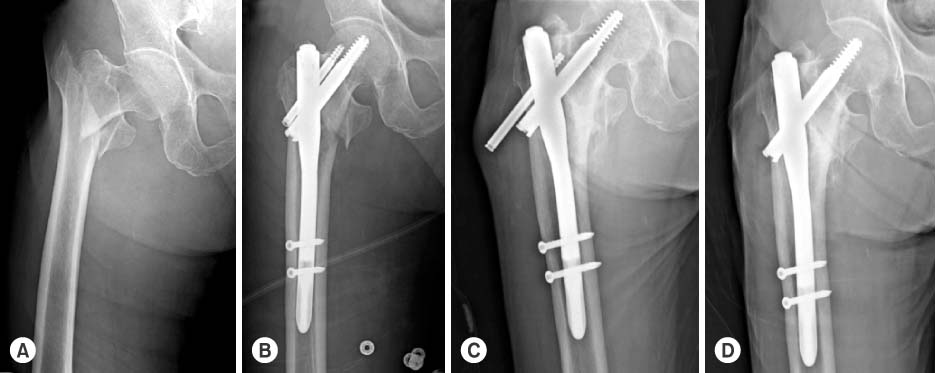
(A) 89 year old female patient presented with intertrochanteric fracture as AO/ASIF classification A2.1.

Figure & Data
REFERENCES
Citations
Citations to this article as recorded by 

- Treatment of the Proximal Femoral Fracture Using the New Design Cephalomedullary Nail: Prospective Outcomes Study
Young Ho Roh, Joseph Rho, Kwang Woo Nam
Journal of the Korean Fracture Society.2019; 32(1): 35. CrossRef - Comparative Study of Intertrochanteric Fracture Treated with the Proximal Femoral Nail Anti-Rotation and the Third Generation of Gamma Nail
Jae-Cheon Sim, Tae-Ho Kim, Ki-Do Hong, Sung-Sik Ha, Jong-Seong Lee
Journal of the Korean Fracture Society.2013; 26(1): 37. CrossRef - Comparative Study of Proximal Femoral Nail Antirotation and Zimmer Natural Nail for the Treatment of Stable Intertrochanteric Fractures
Jee-Hoon Kim, Oog-Jin Shon
Journal of the Korean Fracture Society.2013; 26(4): 305. CrossRef - Helical Blade versus Lag Screw for Treatment of Intertrochanteric Fracture
Kwang-Jun Oh, Sung-Tae Lee, Suk-Ha Lee, Jin-Ho Hwang, Min-Suk Kang
Journal of the Korean Fracture Society.2010; 23(1): 6. CrossRef - Treatment of the Unstable Intertrochanteric Fracture with Proximal Femoral Nail Antirotation: Comparison with Compression Hip Screw with Trochanteric Stabilizing Plate
Tae-Ho Kim, Jong-Oh Kim, Seung-Yup Lee, Geon-Ung Yun
Journal of the Korean Fracture Society.2010; 23(4): 353. CrossRef - Comparison of the Compression Hip Screw (CHS) and the Proximal Femoral Nail Antirotation (PFNA) for Intertrochanteric Femoral Fracture
Jong Min Lim, Jeung Il Kim, Jong Seok Oh, Kuen Tak Suh, Jae Min Ahn, Dong Joon Kang
Journal of the Korean Fracture Society.2010; 23(4): 360. CrossRef
Treatment of Intertrochanteric Fracture: Comparison of Proximal Femoral Nail and Proximal Femoral Nail A



Fig. 1
Proximal femoral nail A (PFNA) and its components (helical blade and its assembly device and nail).
Fig. 2
(A) 72 year old female patient presented with intertrochanteric fracture as AO/ASIF classification A1.1.
(B) We performed closed reduction and intramedullary fixation using PFN.
(C) Radiograph which was taken 3 weeks later shows distal migaration of hip pin and neck screw.
(D) 14 months later post-operatively, radiograph shows more migration of hip pin and neck screw but union was obtained. She complained of pain because of protruded hip pin and neck screw.
Fig. 3
(A) 89 year old female patient presented with intertrochanteric fracture as AO/ASIF classification A2.1.
(B) Postoperative radiograph shows closed reduction and intramedullary fixation using PFN.
(C) Radiograph taken 9 months later shows more migration of hip pin but union was obtained.
(D) So we performed removal of hip pin.
Fig. 1
Fig. 2
Fig. 3
Treatment of Intertrochanteric Fracture: Comparison of Proximal Femoral Nail and Proximal Femoral Nail A
The assessment of social function score
Mobility score of parker and palmer
Comparison of demographic data
Comparison of clinical data
*Age adjusted p-value.
Comparison of radiographic results
*Age adjusted p-value.
Table 1
The assessment of social function score
Table 2
Mobility score of parker and palmer
Table 3
Comparison of demographic data
Table 4
Comparison of clinical data
*Age adjusted p-value.
Table 5
Comparison of radiographic results
*Age adjusted p-value.

 E-submission
E-submission KOTA
KOTA TOTA
TOTA TOTS
TOTS
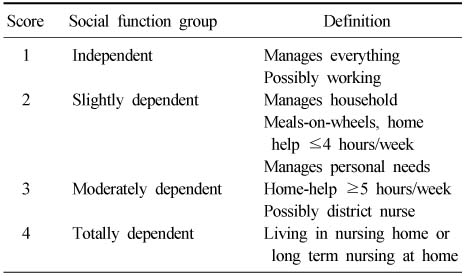
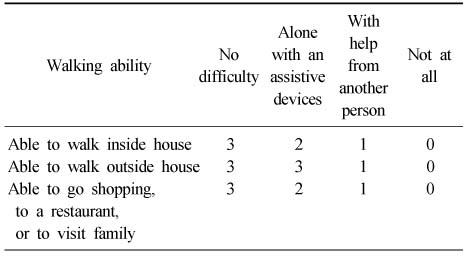
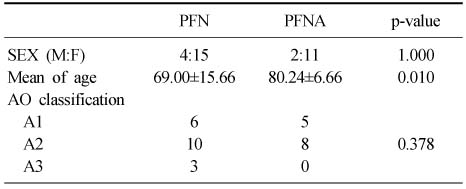
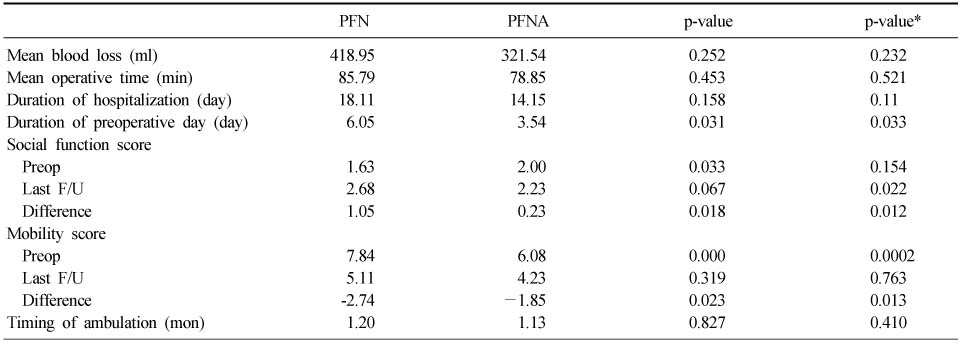

 Cite
Cite

